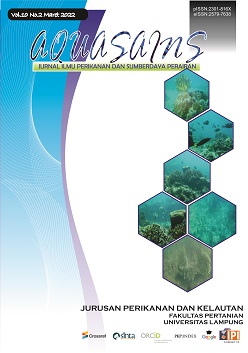UTILIZATION OF FERMENTED SPINACH LEAVES (Amiranthus spinosus L.) IN FEED FORMULATION TO STIMULATE MOLTING OF MANGROVE CRAB (Scylla serrata)
DOI:
https://doi.org/10.23960/aqs.v10i2.p1101-1114 Abstract View: 318
Abstract View: 318
Abstract
There are several techniques that have been developed to accelerate the molting of mud crabs, namely ablation, mutilation and supplementation. One form of supplementation is through the use of fermented spinach leaves on mud crabs. This study aimed to analyze the use of fermented spinach (A. spinosus L) leaves in feed to stimulate the molting of mud crab (S. serrata). This research was conducted for 60 days. The experimental method used in a Completely Randomized Design (CRD) consisting of five treatments and three replications, namely trash fish (P1), Spinach Leaf Fermentation (FDB) 20% (P2), 25% (P3), 30% (P4), and 40% (P5). The results showed that the combination test feed of spinach leaf fermentation had a significant effect on absolute weight and length, specific growth rate (SGR), and feed utilization efficiency, but had no significant effect on feed conversion and survival. Treatment of feed with additional fermented of spinach leaf 30% gave a faster initial molting, which is in the first 10 days with a total of 6 molting crabs and a molting percentage of 40%. Feeding with the addition of 30% and 40% spinach leaf fermented concentrations can provide the best growth and feed efficiency for mangrove crabs.
Downloads
References
Akbar, W., Yusnaini., dan W.H. Muskita (2016). Pertumbuhan Kepiting Bakau (Scylla serrata) Yang Diberi Pakan Usus Ayam Yang Dikukus dan Ikan Rucah. Jurnal Media Akuatika. 1(3), 190-196.
Anderson, A., P. Mather, dan Richardson. (2004). Nutrition Of The mud Crab Scylla serrata (forskal). dalam Proceeding Of Crab Aquaculture In Australia and Southeast Asia. Alla and D. Fielder (editor):57.
Aslamsyah, S. dan Fujaya,Y. (2010). Stimulasi Molting dan Pertumbuhan Kepiting Bakau (Scylla sp.) Melalui Aplikasi Pakan Buatan Berbahan Dasar Limbah Pangan yang Diperkaya dengan Ekstrak Bayam. Ilmu Kelautan. 15(3), 170-178.
Effendie, M. I. (3003). Biologi Perikanan. Yayasan Pustaka Nusantara, Yogyakarta, 163.
Gustiani, E. dan K. Permadi. (2015). Kajian Pengaruh Pembarian Pakan Lengkap Berbahan Baku Fermentasi Tongkol Jagung Terhadap Produktivitas Ternak Sapi PO di Kabupaten Majalengka. Jurnal Peternakan Indonesia. 17(1).
Hanif, A. dan S. Herlina, (2021). Persentase Pemberian Pakan Ikan Rucah Yang Berbeda Terhadap Pertumbuhan Kepiting Bakau (Scylla spp). Jurnal Ilmu Hewani Tropika. 10(1), 1-5.
Haqqi. M. F. (2016). Pengaruh Penambahan Daun Bayam dan Murbei Yang Dikombinasikan Dengan Kapur CaOH Dalam Menstiulasi Molting Kepiting Bakau (Scylla serrata). Skripsi. Program Studi Budidaya Perairan. Universitas Mataram. Mataram. 19-28.
Hudita, K., Agustono., dan W. P, Lokapirnasari. (2020). Penambahan Crude Fish Oil (CFO) Pada Pakan Terhadap Pertumbuhan Dan Rasio Konversi Pakan Pada Kepiting Bakau (Scylla serrata).
Hutagalung, P. (2019). Pengaruh Pemberian Jenis Pakan Yang Berbeda Terhadap Jumlah, Pertumbuhan dan Kelangsungan Hidup Kepiting Bakau (Scylla serata) Yang Bertelur. Jurnal Ilmu Kelautan. 11(2), 4-8.
Megawati, E. (2019) . Pengaruh Penambahan CaO Yang Dicampur Dengan Ekstrak Bayam Terhadap Kecepatan Molting, Pertumbuhan Dan Kelulus Hidupan Kepiting Bakau (Scylla serata). Fakultas Perikanan Dan Kelautan. Prodi Budidaya Perairan. Universitas Riau. Pekanbaru. 1-9.
Muchilis, Z. A., E. Rudi, Muhammad dan I. Setiawan. (2006). Pengaruh Perbedaan Jenis Pakan Dan RAnsum Harian Terhadap Pertumbuhan Dan Kelangsungan Hidup Kepiting Bakau (Scylla serrate). Jurnal Ilmu Kelautan. 11(4), 227:233.
Praing, A. A., M. Zainuri dan R. Pribadi. (2013). Pengaruh Perbedaan Sumber Air Dan Jenis Pakan Terhadap pertumbuhan Dan Kelangsungan Hidup Kepiting Bakau (Scyla serrata) Pada Tambak Desa Mojo. Seminar Nasional XI Pendidikan Biologi FKIP UNS. 11-093.
Sagala, S. L. S., M.Idris dan M. N. Ibrahim. (2013) .Perbandingan Pertumbuhan Kepiting Bakau (Scylla serat) Jantan dan Betina Pada Metode Kurung Dasar.Jurnal Mina Laut Indonesia. 3(12), 46-54.
Samidjan, I., D..Rachamawati dan H. Pranggono. (2019). Rekayasa Teknologi Budidaya Kepiting Bakau (scylla serrata) Melalui Rekayasa Pakan dan Lingkungan Untuk Percepataan Pertumbuhan Dan Kelulushidupan. PENA Akuatika. 18(2).
Septianingsih, E., dan Herlinah. (2016). Injeksi Hormon Dan Ekstrak Tanaman Herbal Sebagai Stimulator Untuk Moling Kepiting Bakau, Scylla sp. Prosiding Forum Inovasi Teknologi Akuakultur.
Sugiani, S., Putra, I., dan Rusliadi. (2014). Maintenance Mud Carb (Scyla serrata ) With Defferent Provision Of Need. Jurnal ilmu kelautan.
Sumaryam dan M. H. Fauzi, (2016). Penambahan Kombinasi Bayam Dan Air Kapur Pada Pakan Untuk Mempercepat Durasi Moulting Kepiting Bakau (Scylla Serrata) Jantan. Prosiding Seminar Kelautan.
Suryani, N. D. P. I., Julyantoro, P. G. S., dan Dewi, A. P. W.K. (2018). Panjang Karapas dan Laju Pertumbuhan Spesifik Kepiting Bakau (Scylla serrata) yang diberi Jenis Pakan Berbeda di Area Ekowisata Kampung Kepiting, Bali. Journal of Marine and Aquatic Sciences. 4(1), 38-46.
Warsyidah, A. A. (2017). Isolasi Dan Identifikasi Bakteri Pada Sayuran Bayam Yang Diperjualbelikan Di Sekitar Jalan Nuri Baru Kota Makassar.Jurnal Agro. 2(5), 15-19.
Yuniarti, T., S. Rejeki dan I. Ihsanudin. (2014). Pengaruh Pemberian Rekombinan Hormon Pertumbuhan (rGH) Melalui Metode Oral Dengan Interval Waktu Yang Berbeda Terhadap pertumbuhan Dan Kelangsungan Hidup Benih Ikan Nila Larasati (Oreocromus Niloticus). Journal of aquaculture management and technology. 3(2). 94-102.
Yuwono. (2006) . Kompos. Penebar Swadaya, Jakarta.

.png)










